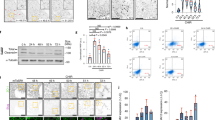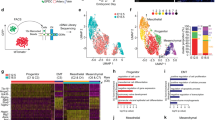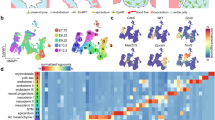Abstract
The epicardial epithelial-mesenchymal transition (EMT) is hypothesized to generate cardiovascular progenitor cells that differentiate into various cell types, including coronary smooth muscle and endothelial cells, perivascular and cardiac interstitial fibroblasts and cardiomyocytes. Here we show that an epicardial-specific knockout of the gene encoding Wilms' tumor-1 (Wt1) leads to a reduction in mesenchymal progenitor cells and their derivatives. We show that Wt1 is essential for repression of the epithelial phenotype in epicardial cells and during embryonic stem cell differentiation through direct transcriptional regulation of the genes encoding Snail (Snai1) and E-cadherin (Cdh1), two of the major mediators of EMT. Some mesodermal lineages do not form in Wt1-null embryoid bodies, but this effect is rescued by the expression of Snai1, underscoring the importance of EMT in generating these differentiated cells. These new insights into the molecular mechanisms regulating cardiovascular progenitor cells and EMT will shed light on the pathogenesis of heart diseases and may help the development of cell-based therapies.
This is a preview of subscription content, access via your institution
Access options
Subscribe to this journal
Receive 12 print issues and online access
$259.00 per year
only $21.58 per issue
Buy this article
- Purchase on SpringerLink
- Instant access to full article PDF
Prices may be subject to local taxes which are calculated during checkout





Similar content being viewed by others
References
Wessels, A. & Perez-Pomares, J.M. The epicardium and epicardially derived cells (EPDCs) as cardiac stem cells. Anat. Rec. A Discov. Mol. Cell. Evol. Biol. 276, 43–57 (2004).
Hohenstein, P. & Hastie, N.D. The many facets of the Wilms' tumour gene, WT1. Hum. Mol. Genet. 15, R196–R201 (2006).
Moore, A.W., McInnes, L., Kreidberg, J., Hastie, N.D. & Schedl, A. YAC complementation shows a requirement for Wt1 in the development of epicardium, adrenal gland and throughout nephrogenesis. Development 126, 1845–1857 (1999).
Hosen, N. et al. The Wilms' tumor gene WT1-GFP knock-in mouse reveals the dynamic regulation of WT1 expression in normal and leukemic hematopoiesis. Leukemia 21, 1783–1791 (2007).
Merki, E. et al. Epicardial retinoid X receptor alpha is required for myocardial growth and coronary artery formation. Proc. Natl. Acad. Sci. USA 102, 18455–18460 (2005).
Nieto, M.A. The snail superfamily of zinc-finger transcription factors. Nat. Rev. Mol. Cell Biol. 3, 155–166 (2002).
Hosono, S. et al. E-cadherin is a WT1 target gene. J. Biol. Chem. 275, 10943–10953 (2000).
Spencer, H.L. et al. E-cadherin inhibits cell surface localization of the pro-migratory 5T4 oncofetal antigen in mouse embryonic stem cells. Mol. Biol. Cell 18, 2838–2851 (2007).
Wagner, K.D. et al. The Wilms' tumor suppressor Wt1 is expressed in the coronary vasculature after myocardial infarction. FASEB J. 16, 1117–1119 (2002).
Keller, G. Embryonic stem cell differentiation: emergence of a new era in biology and medicine. Genes Dev. 19, 1129–1155 (2005).
Nishikawa, S., Jakt, L.M. & Era, T. Embryonic stem-cell culture as a tool for developmental cell biology. Nat. Rev. Mol. Cell Biol. 8, 502–507 (2007).
Wagner, N. et al. Coronary vessel development requires activation of the TrkB neurotrophin receptor by the Wilms' tumor transcription factor Wt1. Genes Dev. 19, 2631–2642 (2005).
Mitiku, N. & Baker, J.C. Genomic analysis of gastrulation and organogenesis in the mouse. Dev. Cell 13, 897–907 (2007).
Miyoshi, Y. et al. High expression of Wilms' tumor suppressor gene predicts poor prognosis in breast cancer patients. Clin. Cancer Res. 8, 1167–1171 (2002).
Blanco, M.J. et al. Correlation of Snail expression with histological grade and lymph node status in breast carcinomas. Oncogene 21, 3241–3246 (2002).
Mani, S.A. et al. The epithelial-mesenchymal transition generates cells with properties of stem cells. Cell 133, 704–715 (2008).
Liu, P., Jenkins, N.A. & Copeland, N.G. A highly efficient recombineering-based method for generating conditional knockout mutations. Genome Res. 13, 476–484 (2003).
Lettice, L.A. et al. The mouse bagpipe gene controls development of axial skeleton, skull, and spleen. Proc. Natl. Acad. Sci. USA 96, 9695–9700 (1999).
Francí, C. et al. Expression of Snail protein in tumor-stroma interface. Oncogene 25, 5134–5144 (2006).
Jat, P.S. et al. Direct derivation of conditionally immortal cell lines from an H-2Kb-tsA58 transgenic mouse. Proc. Natl. Acad. Sci. USA 88, 5096–5100 (1991).
Spraggon, L. et al. hnRNP-U directly interacts with WT1 and modulates WT1 transcriptional activation. Oncogene 26, 1484–1491 (2007).
Niksic, M., Slight, J., Sanford, J.R., Caceres, J.F. & Hastie, N.D. The Wilms' tumour protein (WT1) shuttles between nucleus and cytoplasm and is present in functional polysomes. Hum. Mol. Genet. 13, 463–471 (2004).
Sharpe, J. et al. Optical projection tomography as a tool for 3D microscopy and gene expression studies. Science 296, 541–545 (2002).
Acknowledgements
We thank A. Cano for the Snai1 promoter (Universidad Autónoma de Madrid, Spain), A. García de Herreros for the antibody to Snail (IMIM-Hospital del Mar, Barcelona, Spain), P. Ruiz-Lozano for the Gata5-Cre transgenic mice (Burnham Institute for Medical Research, La Jolla, California), A. Smith for E14Tg2AIV embryonic stem cells (Wellcome Trust Centre for Stem Cell Research, Cambridge, UK), L. Grotewold for CreERT2-puroR expression construct (University of Edinburgh, UK), H. Morrison for the OPT analysis, F. Kilanowski for assistance with gene targeting, A. Thornburn for help maintaining mouse colonies, C. Nicol for assistance with graphics (Supplementary Fig. 7) and all members of N.D.H.'s laboratory for helpful discussions and comments. This work was supported by the UK Medical Research Council (core grant to N.D.H.) and the Spanish Ministry of Science (grant BFU08-02384 to R.M.-C.). A.E. was supported by EuReGene, an FP6 grant from the European Union (05085). O.M.M.-E. was supported by an EU Marie Curie (FP6) personal fellowship.
Author information
Authors and Affiliations
Contributions
O.M.M.-E. designed, conducted and analyzed experiments and wrote the manuscript. L.A.L. generated Wt1loxP/loxP mice. A.E. conducted part of the promoter and ChIP experiments. J.A.G. conducted immunohistochemistry experiments. J.S. assisted with the embryonic stem experiments. V.V. conducted immunohistochemistry and flow cytometry experiments. E.H. and J.R. conducted initial experiments with immortalized epicardial cells. P.S.D. conducted blastocyst microinjection and helped with mouse maintenance. P.H. helped set up genetic crosses and is responsible for the mouse database. N.H. provided the Wt1GFP/+ knockin mice. R.E.H. contributed to discussion. R.M.-C. designed experiments and cowrote the manuscript. N.D.H. obtained funding, helped with the design and analysis of experiments and cowrote the manuscript.
Corresponding author
Supplementary information
Supplementary Text and Figures
Supplementary Figures 1–7 and Supplementary Table 1 (PDF 2032 kb)
Supplementary Movie 1
3D OPT image of control heart (MOV 4224 kb)
Supplementary Movie 2
3D OPT image of mutant heart (MOV 3505 kb)
Rights and permissions
About this article
Cite this article
Martínez-Estrada, O., Lettice, L., Essafi, A. et al. Wt1 is required for cardiovascular progenitor cell formation through transcriptional control of Snail and E-cadherin. Nat Genet 42, 89–93 (2010). https://doi.org/10.1038/ng.494
Received:
Accepted:
Published:
Issue date:
DOI: https://doi.org/10.1038/ng.494
This article is cited by
-
The ELF3 transcription factor is associated with an epithelial phenotype and represses epithelial-mesenchymal transition
Journal of Biological Engineering (2023)
-
Activation of AMPK promotes cardiac differentiation by stimulating the autophagy pathway
Journal of Cell Communication and Signaling (2023)
-
Epicardial slices: an innovative 3D organotypic model to study epicardial cell physiology and activation
npj Regenerative Medicine (2022)
-
Alteration in DNA-binding affinity of Wilms tumor 1 protein due to WT1 genetic variants associated with steroid - resistant nephrotic syndrome in children
Scientific Reports (2022)
-
Hand2 delineates mesothelium progenitors and is reactivated in mesothelioma
Nature Communications (2022)



